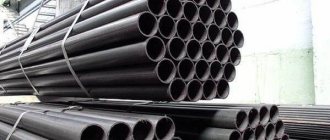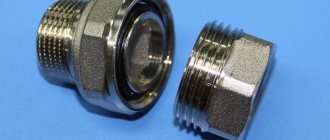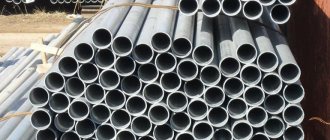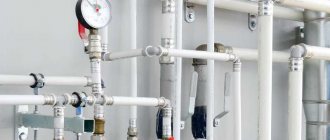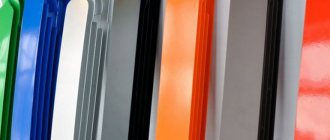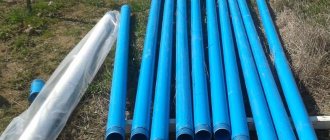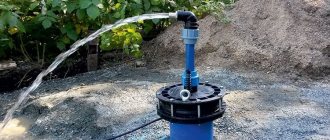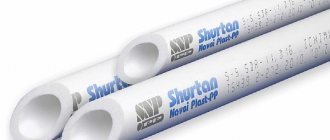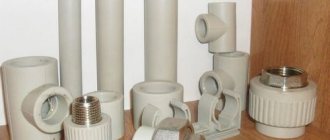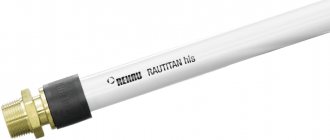Heating pipes with fins have been used for many decades and have not lost their popularity to this day. This equipment has its own design features that determine its use, so they are rarely found in heating systems for private housing, but they are used quite widely for heating industrial premises. A photo of finned heating pipes will tell you what kind of equipment we are talking about, after which we will consider the characteristics of this product in more detail.
Installation of finned heating pipes
Pipe material in heating systems is used not only when installing the heating pipeline, but also as radiators. To increase the efficiency of such a system, a section of pipe with a larger diameter or a shaped design (coil) is cut into the heating circuit, which increases the heat transfer area.
Later, another method began to be used - finning sections of the pipeline that act as radiators.
Thus, finned heating pipes are a pipe fragment of a certain length (carrying pipe) with transverse (less often longitudinal) external ribs located at a certain pitch. The finned pipeline element is equipped with inlet and outlet pipes for connection to the heating system. The pipes of such a radiator can be threaded, smooth surface (welded) or flanged.
One such product, ready for insertion into the heating circuit, is called a single-section register. If several single-section registers are mounted in rows located in one or two planes, you will get a multi-section register - a design that further increases the heating intensity.
* Depending on the material used, fins are performed in different ways, but the purpose of this operation is the same - to improve heat exchange between the heating pipeline and the environment by increasing the area of their contact.
Scope of application of cast iron economizer pipe
Finned cast iron pipes are most widely used in the creation of heat exchangers for steam boilers - economizers (registers). But registers made from economizer pipes are not the best option from a hygiene point of view, since a large amount of dust accumulates between the ribs of the structure. Therefore, most often such structures can be found in industrial and warehouse premises where workers spend a limited amount of time. Cast iron radiators in residential buildings are a prototype of industrial economizers.
Cylindrical pipes are not best suited as radiators because they have insufficient internal volume in relation to surface area.
Heating stationary boilers can be non-boiling and boiling. There are also varieties with a chimney outlet used in residential buildings. Cast iron economizer pipe is used only when installing non-boiling stationary boilers.
Economizer pipes are used to produce space heating devices; these devices are called registers
In addition to being part of the boiler equipment, finned tubes can be used as an independent element of the heating system.
The economizer pipe is connected to other sections using end flanges.
Types of finned pipes
Ribbed pipe heating elements are made of the following metals:
- cast iron (with additions of magnesium and cerium);
- steel;
- stainless steel;
- copper;
- brass;
- aluminum.
According to the structure of the structure, finned pipes are divided into:
- monometallic - solid products obtained by casting or turning from a workpiece;
- bimetallic - products assembled from pipes and ribs.
Monometallic products include cast iron finned pipes, which are manufactured by casting and must meet the requirements of GOST 1816-76, as well as copper and aluminum products, on which the ribs are formed by extrusion/rolling on a machine.
A bimetallic product is an internal supporting pipe made of stainless steel or brass, on which longitudinal or transverse copper or aluminum ribs are located.
Finning of bimetallic pipes is carried out using the following methods:
- rolling - an aluminum or copper coupling is put on the supporting pipe, on which the ribs are extruded using the rolling method;
- spiral-helical winding - a metal strip is pressed into the outer surface of the supporting pipe during spiral winding;
- spiral-screw HDTV - fastening the tape to the supporting pipe by welding the contact surfaces after they are heated by high-frequency current;
- longitudinal (axial) fins – connecting the strip to the supporting pipe using one of the types of welding.
When manufacturing bimetallic pipe registers for heat exchangers, the layout of materials can be as follows (carrying pipe + fins):
- steel + aluminum;
- aluminum + aluminum;
- brass + aluminum
Technical characteristics of cast iron ribbed pipes
*
Cast iron is a strong and durable metal with high thermal conductivity, therefore cast iron finned pipes are most common in heating systems, which are characterized by the following parameters:
- internal diameter – from 32 to 70.0 mm;
- outer diameter (with ribs) – 175.0 mm;
- operating operating temperature – up to 90 degrees. (short-term exposure up to 150 degrees),
- operating coolant pressure in the system – 1.0 MPa;
- the length of individual elements is from 0.5 to 6.0 m.
The shape of the ribs can be round or rectangular. The rectangular format of finned heating pipes is more efficient due to the larger heat transfer surface area.
Which pipes to choose for heating?
Whatever the size of the house under construction or already built, large or small, to create and maintain comfort and warmth in it every day throughout the year, you need a reliable and convenient heating system, for which you can choose finned heating pipes. Let's see if we should choose them. Whether you organize the heat supply yourself or call qualified specialists who will ensure the functioning of the system, the choice of equipment is yours. What points should be used as the basis for the choice so that the heating of the house ultimately turns out comfortable, good and good?
A reliable and convenient heating system is the key to everyday warmth and comfort in the house.
By and large, you can heat the rooms inside the house using a fireplace or stove, you can even use an ordinary electric heater. However, this is difficult, time-consuming and uncomfortable. Hydraulic heating systems with a circulating coolant are more comfortable, when heating is carried out using specially designed devices.
Types of heating systems
In total there are three of them:
- heating appliances;
- convector heaters;
- and devices combining the two previous types.
Heating devices are designed for high volumes of regularly circulating coolant at high temperatures.
Their heat transfer is similar to the “fireplace effect”, when the space around is heated by radiation.
Convector heaters involve the circulation of air masses.
Convector heaters involve the circulation of air masses. The pipes of a convector heater, created in the shape of an “accordion,” pass a coolant through themselves, which heats them. Air masses move from bottom to top through the “ribs” and are heated by their many hot surfaces. As we have already said, there are heat supply devices that combine the properties of both convector heaters and heating devices. The same devices are made by companies such as Korado, Kermi, DeLonghi. These radiators are equipped with storage panels where warm masses of water flow, and their ribbed surfaces are also worth highlighting. In a similar way, both radiation and convection are realized simultaneously.
Distinguishing heating devices by type
Heating devices according to the material of manufacture are divided into:
- cast iron;
- metal;
- steel;
- and bimetallic.
Cast iron has excellent heat transfer and resistance to rust, and can withstand high pressure in a heating system without any problems. The disadvantages of this type are weight (extra heavy) and appearance (cast iron pipes are not often suitable for today’s artistic trends).
Types of heating radiators
Aluminum heating pipes are much lighter and more beautiful when compared to cast iron, and they also have higher heat transfer coefficients. Among the disadvantages, it is necessary to note the high cost and poor tolerance of high pressure in the heating system. Bimetallic ones are products made from a profile pipe, which is considered an overpass for the heat carrier, and an aluminum body. Profile pipes allow the heating system to maintain high pressure, and metal parts successfully cope with the task of heat transfer. It must be said that this type of heating devices has been in use not so long ago.
Better steel systems
But steel stamped products are very popular at the moment, as well as other types, which have high heat transfer coefficients, but are more affordable in the price category. There are many manufacturers of stamped steel heating devices, but all products are produced according to a single standard and externally they are similar to each other.
Diagram of both heating radiator connection options
The manufacturing process uses very high-quality cold-rolled steel. Heating devices include several (two or three) flat panels, which act as a conductor for the heat carrier, and ribbed surfaces between them, the heating of which occurs from the panels, and their location is such that vertical air flows can circulate freely. The panels transfer heat through radiation, and the ribbed surfaces transfer heat through convection. The connection of such products to the heating system is carried out from below or from the side. Heating devices connected from below are easier to install and more aesthetically pleasing on the outside. Moreover, such products are equipped with a built-in thermostatic valve, on which, if desired, you can install a thermostat, which makes it possible to automatically control and maintain the desired temperature in the room. Steel convector heaters (aka finned tubes) are used mainly for heating industrial buildings, production buildings, and livestock farms. The temperature of the water heat carrier in the system is 90°C, the steam one is 120°C. Excessive operating pressure can reach 1.0 MPa (otherwise - 10 kgf/cm2), and the linear heat flux density - 0.6 kW/m.
Parameters of ribbed products
Finned pipes have a significantly larger surface area than smooth pipes of similar diameter and length. This is actually why the heat flux density in them is radically different. Also, this affects the size and appearance - ribbed heating products are much more compact. The disadvantages of a finned tube include the low resistance of the fins to mechanical influences and the difficulty of cleaning from dust. Finned tubes are galvanized inside and outside by hot dipping. Their heat transfer rates are incredibly high (which is documented). Installation is carried out using conventional connectors. Based on manufacturing size, convector heaters are divided into:
- by diameter (DN32 and DN40);
- and length (1 m, 1.8 m, 2.8 m).
Other dimensional characteristics are possible by agreement with the manufacturer. The diameter of the heat sink is 100 mm. Ribbed convector heaters will typically last at least 5 years. The warranty period is 24 months from the date of putting the product into operation, but up to 36 months from the date of receipt by the consumer. The set with the convector heater comes with a product data sheet. Nowadays, economizer cast iron pipes have become very popular. They are distinguished by better heat retention than standard cast iron ones, and their length can reach several meters.
The use of cast iron in the manufacture of pipes for heating systems significantly increases their service life. For cleaning, it is best to use steam or gas pulse methods: clean surfaces will save on fuel. The composition of economizers includes pipes with fins, interconnected and fixed into an insulating frame. Upon special order, the manufacturer can equip products with a gas supply box.
Share a useful article:
Advantages and disadvantages of finned tubes
*
It is thanks to a number of advantages that cast iron finned heating pipes are used in heating systems to this day; we list these factors:
- housing tightness;
- large heat transfer area;
- neutral to any type of corrosion;
- high thermal conductivity;
- strength;
- durability (100 years is not the limit);
- affordable price.
But there are also disadvantages:
- significant weight;
- low resistance to impact;
- difficulty in keeping clean (accumulation of dust in the fins, poor accessibility of the painting area);
- bulkiness.
Finned metal pipes: what they are and why they are needed
Finned tubes are equipped with iron ribs, as a result of which their outer surface increases. This leads to an increase in heat transfer efficiency by 1.5 times. Finned products are used in industry and in domestic tasks and purposes. They are used for the construction of pipe coils and coolers, heating systems, industrial refrigeration chambers, and metal communications.
Finned pipes - products with special qualities and parameters
Design and scope of use of finned tubes
Finned tubes are monometallic or bimetallic structures, which consist of two components:
- Inner pipe. This is a load-bearing component through the internal voids of which the working medium moves. It is made of metal, very often steel. Cast iron and multi-colored metals are used very rarely. The material from which the internal part of the structure is made is resistant to temperature changes and high pressure, and has anti-corrosion characteristics.
- External ribs. They can also be made of steel, cast iron and non-ferrous metals. External ribs effectively transfer the heat coming from the load-bearing element.
Finned tubes are used in a variety of areas of human activity:
- the mechanical engineering industry uses them in refrigeration units, oil coolers and compressors;
- chemical, petrochemical and petrochemical - in condensers, gas heaters and gas coolers;
- nuclear energy - in gas coolers, intermediate refrigerators, steam air heaters, drying towers;
- in technology for clean air;
- in heat exchange units.
Pipes with iron fins are used as cooling, heat exchange and other devices at various facilities
Production and characteristics of finned tubes
The manufacturing option for products depends on their purpose and related technical specifics.
Typically, fully automated helical fins are used, in which a continuously welded helix runs around the inner tube. This can be done in three ways:
- Rolling.
- Aluminum winding.
- By winding with welding.
No further processing is required; the product has the following characteristics:
- partially increased heat transfer rate;
- very high resistance to loads;
- maintaining specified parameters when pressure increases, temperature changes and other sudden changes in operating conditions;
- increasing the productivity of the equipment that was equipped with it.
Main! Spiral fins provide the ability to reduce pipe flow while reducing the weight of the pipe coils.
Coating a pre-degreased finned tube with magnesium oxide and further annealing can give it a heat-resistant coating. Similar products have:
- increased heat transfer rate by more than 1.5 times;
- very high resistance to a wide variety of corrosion;
- increased performance;
- high service life;
- increased resistance to changes in pressure and temperature;
- Possibility of use in aggressive environments.
The manufacturing option of pipes, the shape of the fins and the method of their fastening are reflected in the technical properties of the products and form the scope of use
Advantages of using heat-resistant finned tubes
Heat-resistant finned products obtained as a result of the use of modern developments have a number of positive qualities that have led to their wide distribution. They stand out:
- high manufacturability. The use of contact welding does not require a huge amount of energy, nor special consumables, nor complex equipment;
- increased intensity of convective heat transfer. In the space of the intercostal channels, turbulization of the flow of the working medium occurs, and all sections of the fins also work perfectly;
- remarkable thermal contact between the load-bearing structural element and the ribs. The use of resistance welding has provided an excellent opportunity to achieve virtually remarkable thermal contact;
- lower thermal resistance of heat transfer. Since the thickness of the condensate film has decreased, the level of condensation of vapors flowing through the pipeline of the innovative liquid has decreased. This happens due to the presence of a heat-resistant coating.
Ribbed cast iron pipe
Technological progress has made it possible to produce ribbed cast iron structures. This made it possible to use cast iron finned heating pipes. After all, heating systems are literally the perfect environment for the use of ribbed cast iron products. They have the following good qualities:
- high resistance to corrosion caused both by the influence of the operating fluid inside and by the environment;
- ease of installation;
- high heat transfer coefficient;
- compactness;
- at a small price.
Finned pipes made of cast iron have many positive qualities, one of them is resistance to high temperatures
Ribbed cast iron products are not without their disadvantages. They:
- have the property of collecting poorly cleaned dust between the ribs;
- weigh a lot;
- fragile under mechanical stress.
You need to pay attention! The listed disadvantages make it possible to use ribbed cast iron pipes to create heating registers in production and warehouse premises.
For registers, ribbed cast iron pipes are specially made in the form of hollow heating devices, sometimes equipped with connecting threads or flanges at the edges to ensure docking with other heating system elements.
And cast iron radiators for residential premises continue to be in very high demand, as they maintain temperatures of one and a half hundred degrees. A cast iron starting pipe is often built into the design of heating systems. As a result, the heating stove heats the space around it faster.
Economizer cast iron pipe
When making industrial pipe coils, finned cast iron pipes are simply valuable. For industrial registers (economizers), cast iron pipes with ribbed walls are available either with rounded ribs or a quadrangular shape. The internal diameter is seventy millimeters, the external diameter is 175 mm. The significant difference between the values of the outer and inner diameters makes it possible to acquire a relatively low temperature on the surface, despite the fact that the coolant will be very hot.
Cast iron pipes often have a flange type connection
Economizer cast iron pipes are available for sale in lengths of 2 or three meters. They are equipped with 2 blind plugs and 2 plugs with holes - left-handed (o) and right-handed. The inconveniences associated with transporting heavy economizer cast iron structures that are weakly resistant to impacts, scratches, etc. will more than pay for themselves if they are used correctly. When using economizer parts, it is recommended:
- expose the mounted structures to very little external action;
- do not allow the temperature of the coolant to increase. Economizer pipes can withstand short-term heating of the coolant up to one hundred and fifty degrees, but it would be nice not to raise the temperature above 95? WITH;
- use a regularly operating pressure of six to ten atmospheres. Although it is possible to connect to steam boilers with operating pressures up to 24 atm;
- cover the surface from the outside with a specialized primer mixture;
- When performing installation, make sure that the distance from the middle axis of the register to the side wall is more than 130 mm, and to the floor - more than two hundred millimeters;
- By installing the registers in 2 rows and combining them with each other using a specialized arc, they keep the distance between the middle axes equal to 250 mm.
By adhering to operating rules, you can achieve the highest operating efficiency of economizer cast iron pipes.
Caulking of cast iron pipes
Since external sewer networks are made primarily of cast iron, it is impossible to do without caulking and caulking. Caulking takes place when assembling a system that includes cast iron pipes to seal the cracks that appear at the site where the transition to another cast iron pipe is made. It is done using:
- Resin sealant and cement mortar.
- Slightly damp cement mixture and asbestos fiber.
- Gray fills.
Main! When caulking, the pipes are carefully tapped with a hammer so that the bell moves freely.
If the bell could not be released, it means that sulfur filling was used. They carefully burn it out, first of all wearing a respirator. Having freed the bell, it is thoroughly cleaned. A sealing ring coated with a specialized lubricant is placed into the socket, and a new part is placed into it.
Finned pipes for heating systems - what are they and why are they needed?
Everyone knows that finned tubes for pipe coils are widely used in hydraulic mechanisms and in a wide variety of industrial sectors for good heat removal from working fluids and gases. At the same time, not everyone knows that such pipes are often found in the everyday life of any resident of an apartment or private home, for example, in cooling and air conditioning systems, as well as in household heating systems.
Types of finned tubes
Specifics of using finned tubes
In order to learn in detail the scope of use and the main consumer qualities of metal finned pipes, in this article we will consider the main technical properties of such products, and also briefly describe the technology of their manufacture.
The reader will also be offered short instructions on the operation and care of iron finned tubes, which are used in household heating and air conditioning systems.
Technical designation on the drawing
Technical properties
In order to get a clear idea of any product, you first need to learn its main technical properties.
- Diameter. Metal pipes with a diameter of 5 to 219 mm and a wall thickness of 1 to 15 mm serve as the basis for applying cooling fins, but samples with a diameter of 10 mm, 16 mm, 19 mm, 25 mm and 50 mm are very common.
- Ribs sizes. The height of the fin can be from 8 to 28 mm, the thickness from 0.8 to 2.5 mm, and the distance between the turns can be from 3.6 to 25 mm.
- Pipe length. The entire length of finished products can be in the range from 1500 to 24000 mm.
- Materials. In most cases, the material for the production of finned pipes is selected depending on its purpose. Alloys made of copper and other non-ferrous metals, for example brass grade L68 or L96, have the best heat transfer.
- Reinforced pipes. In severe operating conditions (hazardous environment, high pressure), pipes made of stainless steel 12Х18Н10Т or copper-nickel alloy MNZHMts 30-1-1 are used as a base.
The figure below shows: D – diameter, S – rib height, b – thickness, t – distance between them.
This is how the finned tubes in the middle are arranged
You need to pay attention! The effectiveness of heat transfer from a heating radiator is affected not only by the material, but also by the fin rating of the pipes. It is expressed in relation to the entire area of the finned surface, to the surface area on the outside of the key pipe.
- Good heat conductivity. Cooling fins have a high heat transfer coefficient and low thermal conductivity resistance, which makes it possible, with the same length and diameter of the pipeline, to significantly speed up the heat transfer process.
- Great strength. The material from which they are made allows operation in a wide temperature range (from very low to very high) at very high pressure.
Finned copper pipes are considered the most effective
- Durability. Products with a finned surface have a very long service life, but can work effectively only if there is no contamination on the fins and between them, so they require periodic cleaning during operation.
- Design features. The cooling fins are made of a thinner and softer material than the main pipe, so they must be handled with care and must be covered with a breathable protective shield to protect them from mechanical damage.
Monomethyl aluminum radiators
You need to pay attention! Monometallic heating devices have quite high strength, better tightness and low thermal resistance to heat transfer when compared with bimetallic ones. At the same time, the too high cost of such products makes their global use in the national economy meaningless.
Area of use
As we said at the beginning of the publication, such products are widely used in virtually all industrial sectors, but with a very detailed study of this issue, they can always be used in subsidiary farming.
- Heat supply for residential buildings. For example, by using pipe fins with your own hands, you can create an effective heating system for a country house.
- Heating of domestic buildings. Profile pipes with cooling fins can be used as heating devices for heating greenhouses, greenhouses, animal pens, and other non-residential premises.
- Climatic equipment. In addition to everything else, such products are used in virtually all liquid heating devices (heating boilers, gas water heaters), as well as in refrigerators and home climate control equipment (air conditioners, chillers, fan convectors).
Copper heat exchangers for gas-fired dispensers
Conclusion
Based on the results of this article, we can conclude that pipes with lateral finned surfaces on the outside, which have very high heat transfer, can be successfully used for arranging heating systems and heating water in farmsteads.
To get additional information on an issue of interest, you can watch the video in this article or read other materials of a similar style on this site. If you still have questions, you can discuss them in the comments below.
